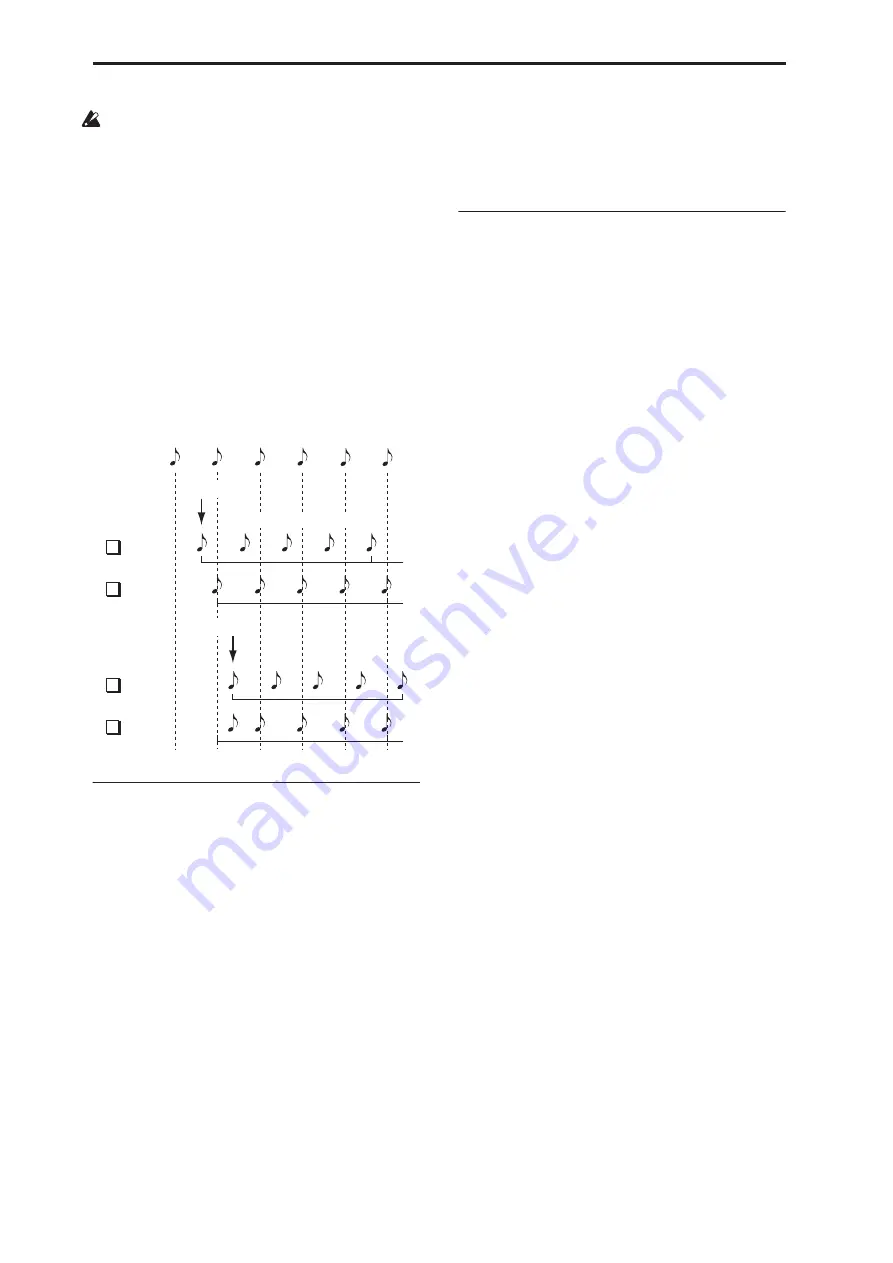
Global mode
666
The
Quantize Triggers
parameter on this page
affects the way that the Wave Sequence plays back
during editing, but is not stored with the Wave
Sequence itself. Instead, each Program, each Combi
Timbre, and each Track in a Song has its own
Quantize Triggers
setting.
How Quantize Triggers works
The
Quantize Triggers
feature tries to make a good
guess at where you intended the note to be. If you play
the note just a bit late–within a 32nd note of the 8th
note–it will assume that you meant the note to sound
on the beat that just passed. In this case, the note will
play immediately.
On the other hand, if you play the note up to three
32nd notes early, it will assume that you’re intending
the note to sound on the next beat. In this case, the
note-on is delayed until the next 8th note.
Quantize Triggers
4–1b: Graphic
The graphic gives you a visual overview of the Wave
Sequence:
• The current step is marked by a red arrow.
• Red boxes are Multisample steps.
• Green boxes are Tie steps.
• White boxes are Rest steps.
• The length of the Wave Sequence, from the Start
Step to the End Step, is shown by a rectangular
outline.
• The Loop is hilighted in blue.
Step
[1…64]
This selects the current step. This is convenient when
setting the Start, End, Loop Start, or Loop End steps.
Multisample (Read-Only)
[Bank, Number,
and Name]
This shows the bank, number, and name of the current
step’s Multisample.
Solo [Off,
On]
This button solos the current step, so that you can hear
it quickly and easily. When
Solo
is
On
, the Wave
Sequence will play only the current step, including the
fade-in and fade-out.
4–1c: Wave Sequence
Start Step
[1…64]
This is the step on which the Wave Sequence starts.
You can modulate this via AMS.
Note:
When
Note-On Advance
is
On
,
Start Step
modulation is disabled. For more information, see
“Note-On Advance” on page 667.
AMS
[List of AMS Sources]
This selects a modulation source to control the Start
Step. For a list of AMS sources, see “AMS (Alternate
Modulation Source) List” on page 967.
Intensity
[–63…+63]
This controls the depth and direction of the Start Step
modulation. Negative modulation moves the Start
Step earlier in the sequence, to the limit of Step 1.
Positive modulation moves the Start Step later in the
sequence, to the limit of the End Step.
End Step
[1…64]
This sets the number of steps in the Wave Sequence.
Length (Read Only)
[1…64]
This read-only display shows the total number of steps
in the Wave Sequence, based on the
Start Step
and
End
Step
.
Swing Resolution
[
3
…
]
This sets the resolution which will be used for swing. If
a Program contains multiple Wave Sequences with
different
Swing Resolution
settings, the Program will
use the finest value. For instance, if one Wave Sequence
is set to
1/8
and the other is set to
1/16
, the Program
will use
1/16
.
While the resolution is stored in the Wave Sequence,
the swing amount is set in the Program, Combi Timbre,
or Song Track. This lets you use a single Wave
Sequence in different Programs, Combis, and Songs,
each with different amounts of swing.
Loop Parameters
Wave Sequences can loop, so that some or all of the
steps are played repeatedly–like a drum loop, or a loop
in a sequencer.
You can set the start and end of the loop separately
from the start and end of the Wave Sequence itself. The
loop can either play for as long as the note is played, or
repeat a specified number of times. Finally, you can
choose whether the loop plays forwards, plays
backwards, or alternates between backwards and
forwards.
Loop Start Step
[1…64]
This is the step on which the loop starts.
Quantize
Triggers
✓
Quantize
Triggers
Quantize
Triggers
✓
Quantize
Triggers
Note-On
Note-On
Wave Sequence Rhythm
Содержание Electronic Keyboard
Страница 1: ...Parameter Guide Parameter Guide ...
Страница 2: ......
Страница 180: ...Program mode EXi 170 ...
Страница 290: ...EXi STR 1 Plucked String 280 ...
Страница 572: ...Sequencer mode 562 ...
Страница 700: ...Global mode 690 ...
Страница 751: ...Insert Effects IFX1 IFX12 Routing 741 Fig 2 3a Fig 2 3b ...
Страница 902: ...Effect Guide 892 ...






























